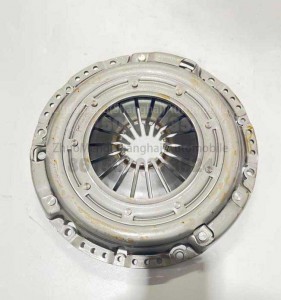SAIC Relay – 5 p C00000041 for MAXUS V80
Short Description:
Product Detail
Product Tags
Products information
| Products name | Relay - 5 p |
| Products application | SAIC MAXUS V80 |
| Products OEM NO |
C00000041 |
| Org of place | MADE IN CHINA |
| Brand | CSSOT /RMOEM/ORG/COPY |
| Lead time | Stock,if less 20 PCS,normal one month |
| Payment | TT Deposit |
| Company Brand | CSSOT |
| Application system | Chassis system |
Related products


Product knowledge
Test of relayrelay Relay is the key device of intelligent prepaid electricity meter. The life of relay determines the life of electricity meter to some extent. The performance of the device is very important to the operation of intelligent prepaid electricity meter. However, there are many domestic and foreign relay manufacturers, which differ greatly in production scale, technical level and performance parameters. Therefore, energy meter manufacturers must have a set of perfect detection devices when testing and selecting relays to ensure the quality of electricity meters. At the same time, State Grid has also strengthened the sampling detection of relay performance parameters in smart electricity meters, which also requires corresponding detection equipment to check the quality of electricity meters produced by different manufacturers. However, relay detection equipment not only has a single detection item, the detection process cannot be automated, the detection data need to be processed and analyzed manually, and the detection results have various randomness and artificiality. Moreover, the detection efficiency is low and the safety cannot be guaranteed [7].In the past two years, The State Grid has gradually standardized the technical requirements of electricity meters, formulated relevant industry standards and technical specifications, which put forward some technical difficulties for relay parameter detection, such as load on and off capacity of relay, switching characteristics test, etc. Therefore, it is urgent to study a device to achieve comprehensive detection of relay performance parameters [7].According to the requirements of relay performance parameters test, the test items can be divided into two categories. One is the test items without load current, such as action value, contact resistance and mechanical life. The second is with load current test items, such as contact voltage, electrical life, overload capacity.The main test items are briefly introduced as follows :(1) action value. Voltage required for relay operation. (2) Contact resistance. Resistance value between two contacts when electric closure. (3) Mechanical life. Mechanical parts in the case of no damage, the number of times the relay switch action. (4) Contact voltage. When electric contact is closed, a certain load current is applied in the electric contact circuit and the voltage value between the contacts. (5) Electrical life. When the rated voltage is applied at both ends of the relay driving coil and the rated resistive load is applied in the contact loop, the cycle is less than 300 times per hour and the duty cycle is 1∶4, the reliable operation times of the relay. (6) Overload capacity. When the rated voltage is applied at both ends of the relay's driving coil and 1.5 times of rated load is applied in the contact loop, the reliable operation times of the relay can be achieved at the operation frequency of (10±1) times/min [7].Types, for example,, many different kinds of relay, can be divided by input voltage relay speed, current relay, time relay, relay, pressure relays, etc., according to the principle of work can be divided into electromagnetic relay, induction type relays, electric relay, electronic relay, etc., according to the purpose can be divided into the control relay, relay protection, etc., According to the input variable form can be divided into relay and measurement relay. [8]Whether or not the relay is based on the presence or absence of input, relay does not operate when there is no input, relay action when there is input, such as intermediate relay, general relay, time relay, etc. [8]Measuring relay is based on the change of input, the input is always there when working, only when the input reaches a certain value of the relay will operate, such as current relay, voltage relay, thermal relay, speed relay, pressure relay, liquid level relay, etc.. [8]Electromagnetic relay Schematic diagram of electromagnetic relay structure Most of the relays used in control circuits are electromagnetic relays. Electromagnetic relay has the characteristics of simple structure, low price, convenient operation and maintenance, small contact capacity (generally below SA), large number of contacts and no main and auxiliary points, no arc extinguishing device, small size, rapid and accurate action, sensitive control, reliable, and so on. It is widely used in low-voltage control system. Commonly used electromagnetic relays include current relays, voltage relays, intermediate relays and various small general relays. [8]Electromagnetic relay structure and working principle is similar to contactor, mainly composed of electromagnetic mechanism and contact. Electromagnetic relays have both DC and AC. A voltage or current is added at both ends of the coil to generate electromagnetic force. When the electromagnetic force is greater than the spring reaction force, the armature is drawn to make the normally open and normally closed contacts move. When the voltage or current of the coil drops or disappears, the armature is released and the contact is reset. [8]Thermal relay Thermal relay is mainly used for electrical equipment (mainly motor) overload protection. Thermal relay is a kind of work using the current heating principle of electric equipment, it is close to motor allow overload characteristics of inverse time characteristics, mainly used together with the contactor, used for three-phase asynchronous motor overload and phase failure protection of three-phase asynchronous motor in the actual operation, are often faced with caused by electrical or mechanical reasons such as over current, overload and phase failure). If the over current is not serious, the duration is short, and the windings do not exceed the allowable temperature rise, this over current is allowed; If the over-current is serious and lasts for a long time, it will speed up the insulation aging of the motor and even burn the motor. Therefore, the motor protection device should be set up in the motor circuit. There are many kinds of motor protection devices in common use, and the most common one is metal plate thermal relay. metal plate type thermal relay is three-phase, there are two kinds with and without phase break protection. [8]Time relay Time relay is used for time control in control circuit. Its kind is very much, according to its action principle can be divided into electromagnetic type, air damping type, electric type and electronic type, according to the delay mode can be divided into power delay delay and power delay delay. The air damping time relay uses the principle of air damping to obtain the time delay, which is composed of electromagnetic mechanism, delay mechanism and contact system. The electromagnetic mechanism is direct-acting double E-type iron core, the contact system uses I-X5 micro switch, and the delay mechanism adopts airbag damper. [8]reliability1. Influence of environment on relay reliability: the average time between failures of relays operating in GB and SF is the highest, reaching 820,00h, while in NU environment, it is only 600,00h. [9]2. Influence of quality grade on relay reliability: when A1 quality grade relays are selected, the average time between failures can reach 3660000h, while the average time between failures of C-grade relays is 110000, with a difference of 33 times. It can be seen that the quality grade of relays has a great influence on their reliability performance. [9]3, the influence on the reliability of the relay contact form: relay contact form will also affect its reliability, single throw the reliability of the relay type were higher than the number of the same knife type double throw relay, reliability gradually reduce with the increase of the number of knife at the same time, is the average time between failures single-pole single-throw relay four knife double-throw relay of 5.5 times. [9]4. Influence of structure type on relay reliability: there are 24 types of relay structure, and each type has an impact on its reliability. [9]5. The influence of temperature on the reliability of relay: the operating temperature of relay is between -25 ℃ and 70℃. With the increase of temperature, the average time between failures of relays decreases gradually. [9]6. Influence of operation rate on relay reliability: With the increase of operation rate of relay, the average time between failures basically presents an exponential downward trend. Therefore, if the designed circuit requires the relay to operate at a very high rate, it is necessary to carefully detect the relay during circuit maintenance so that it can be replaced in time. [9]7. Influence of current ratio on the reliability of relay: the so-called current ratio is the ratio of the working load current of relay to the rated load current. The current ratio has a great influence on the reliability of relay, especially when the current ratio is greater than 0.1, the average time between failures decreases rapidly, while when the current ratio is less than 0.1, the average time between failures basically stays the same, so the load with higher rated current should be selected in circuit design to reduce the current ratio. In this way, the reliability of relay and even the whole circuit will not be reduced due to the fluctuation of working current.

FAQ
1. I want to talk with you ,but time different ,how to solve?
Yes ,its trade,we can help you with order in your time till all solved
2. What time do you work ? if i will disturb you ?
NO ,you will not disturb me ,All the time by your free time we can serve you !
3. how to find right products for me?
1. search for products name
2. Find from website catalog
3. Give us picture
4. Take picture for us and find OEM NO from products
4 .Any one I can talk directly ?
Sweety wechat/whatsapp/phone :+8615000373524 email:mgautoparts@126.com
5. Can we get discount from you ?
Yes,buy mass ,we can give you big discount !
6. can we pay your company fixed depoist ?
Yes,fixed deposit you can pay us ,when you wanna make order and confirmed and we can use your deposit and prepare your products as list !
7. If we can get some certificate to clear for our products ?
Yes,we can ,if all cost bear by your company ,we can help you do these certificate and help you do all so that we can send out successfully !
8. if you want to do saic package/label for me ?
NO ,SAIC will find this ,if you wanna make it and you can make it in your place and print it on box !but products same with SAIC one !
9. If you can tell me how to install if I bought from you ?
Sorry ,this we can not help you ,you can buy our products and take it to your local car center and with professional man to help you install ,otherwise ,if install wrong ,products will broken with some other parts together !it need more care!











